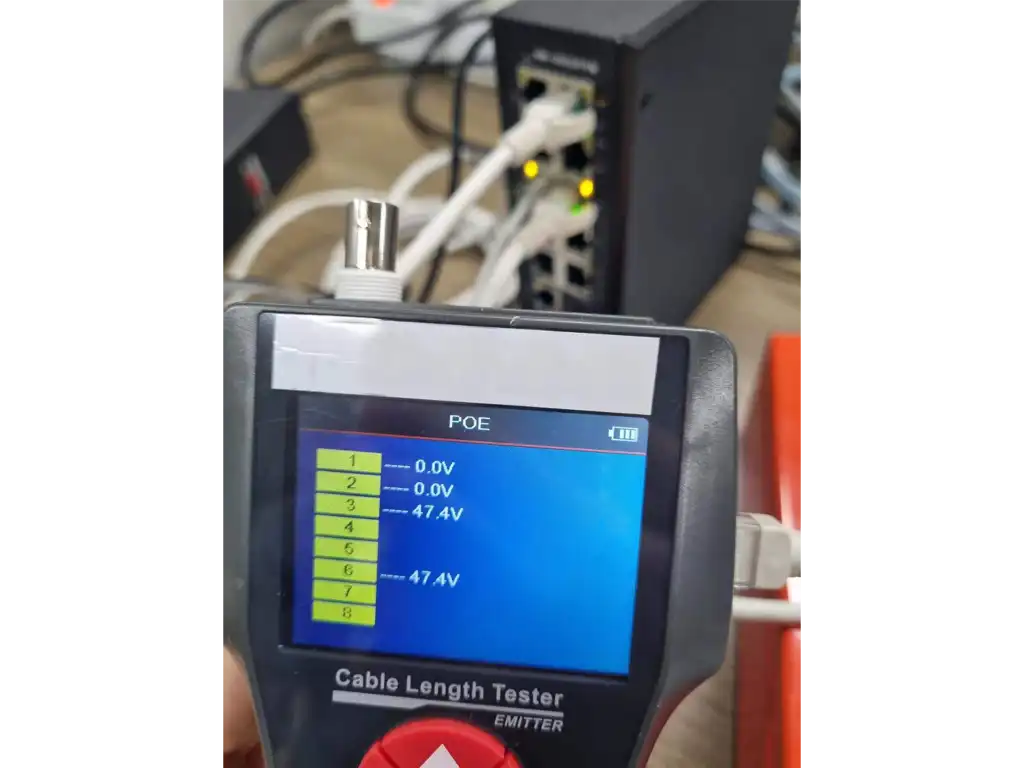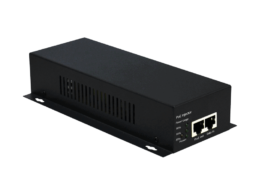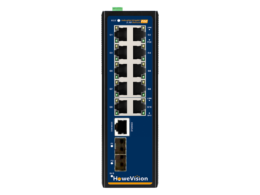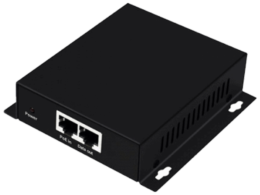Power over Ethernet (PoE) technology has become a staple in modern network design, allowing power and data to be transmitted over a single Ethernet cable. This simplifies the installation of networked devices and can significantly reduce costs. As technology evolves, new standards emerge to improve the capabilities of PoE, enhancing its efficiency and expanding its applications.
The latest standard in the PoE series is the IEEE 802.3bt, also known as PoE Class 4. This new standard raises the bar for network optimization by increasing the maximum power delivered to devices through the Ethernet cable. With Class 4, devices can receive up to 90 watts of power, a significant jump from the previous limit of 30 watts with the earlier 802.3at standard.
This increase in power capacity opens up new possibilities for network design. High-powered devices such as digital signage, advanced IP cameras, and even thin clients can now be powered directly through the network cable, eliminating the need for separate power sources and reducing the complexity of installations.
Moreover, PoE Class 4 supports more efficient power management with features like Autoclass, which allows devices to communicate their specific power needs to the network switch. This ensures that each device receives precisely the amount of power it requires, not more, not less, optimizing energy consumption and reducing waste.
Additionally, with the enhanced power capabilities, network designers can now place devices in previously tricky or impossible locations due to power constraints. This flexibility is particularly beneficial in large-scale deployments such as smart buildings or extensive surveillance systems.
In summary, PoE Class 4 is a game-changer for network optimization. It allows for more excellent power delivery to a broader range of devices while promoting efficient energy usage and broadening the scope of PoE applications. As networks grow and demand for intelligent, high-powered devices increases, adopting the latest PoE standard becomes essential for creating robust and future-proof network infrastructures.
Overview of PoE Technology and Standards
PoE Defined
Power over Ethernet, or PoE, is a technology that allows network cables to carry electrical power, with a PSE (Power Sourcing Equipment) like a switch providing DC power to a PD (Powered Device). For devices like IP cameras and VoIP phones, a single ethernet cable provides data connection and electric power through passive PoE, using a pair PoE switch. It simplifies ethernet cabling and reduces the need for additional electrical services with a PoE switch.
With PoE, installation becomes less complex. You don’t need an electrician to fit new power sockets near each device location for PD, Ethernet cables, or a PoE switch. This can lead to significant savings in setup costs.
Evolution History
Developing PoE standards for ethernet, including PD and PSE, has been pivotal in its adoption for DC power delivery. The original IEEE 802.3af-2003 standard, also known as PoE (Power over Ethernet), provided up to 15.4 Watts of DC power (minimum 44V DC at 350mA) on each port of a PoE switch but only about 12.95 Watts was assured to be available at the PD (Powered Device) as some power is dissipated in the cable along with data transmission.
Later advancements in ethernet technology led to IEEE 802.3at-2009, also known as PoE+ or PoE plus, which increased the available power per port to 30 Watts (minimum 50V DC at 600mA) and allowed for both power sourcing equipment (PSE) and powered devices (PD) to be connected over a single cable. This allowed more types of devices – including those with higher energy demands such as PTZ cameras or dual radio WAPs, to be powered using PoE technology over Ethernet cable by PD and PSE.
In recent years, IEEE introduced the latest standard: IEEE 802.3bt-2018 for Ethernet, which further expands capabilities by offering up to four pairs of wires for powering devices such as PDs (Powered Devices) up against just two previously used pairs in a PoE switch and supports up to approximately 60W on Type Three (IEEE PSE Class Four) ports with even higher levels on Type Four ports, using DC power.
Traditional Comparison
There are clear advantages when comparing traditional methods of delivering electricity with today’s advanced PoE standards, which involve ethernet, PD (Powered Devices), PSE (Power Sourcing Equipment), and utilizing pairs of wires for power and data transmission.
- Cost efficiency: Reducing material and labor costs.
- Flexibility: Devices can be placed where they are needed most without concern for proximity to electrical outlets, thanks to PoE switch technology delivering power and data over Ethernet using PD pairs.
- Safety: Lower voltages reduce risk; there is no need for exposed wiring in PoE devices using PD pairs to transmit data.
- Reliability: Fewer points of failure when removing separate power sources and using PD pairs with a PSE for data.
- Simplicity: Streamlined infrastructure due mainly in part because it requires only one pair of cables instead of two separate ones—one for data, the other for electricity—thus reducing clutter, improving aesthetics, and incorporating PD and PSE within the environment where deployed.
The comparison underscores why many businesses prefer adopting modern PoE solutions with pd, pair, and pse.
Understanding the IEEE 802.3bt PoE Standard
Enhanced Capabilities
The IEEE 802.3bt standard marks a significant leap in PoE technology, enhancing both PSE (Power Sourcing Equipment) and PD (Powered Device) capabilities across all four pairs. It expands upon previous iterations by increasing the maximum power that devices can handle, incorporating PD and PSE, and allowing for pairing. This PD enhancement allows a broader range of applications and devices to be powered through paired Ethernet cables with PSE.
With this Power over Ethernet (PoE) standard, there’s an increase in efficiency and scalability for network designs, allowing both power (PD) and data (pair) to be transmitted over a single Ethernet cable by the power sourcing equipment (pse). For instance, LED lighting systems benefit from higher power levels without needing traditional electrical wiring solutions. The rise in power delivery (PD) capabilities means more robust networking equipment can receive sufficient power over Ethernet (PoE).
Power Delivery
The new PoE Class 4 PD provides up to 60 watts of power per port, doubling what was available before with PoE Class 3 PD, which offered up to 30 watts. This jump is crucial for high-performance devices that require more energy.
Devices like pan-tilt-zoom (PTZ) cameras or video-conferencing systems often need more than the previously established limits allowed by older standards such as PoE Class 2 or PoE Class 1, which provided lower wattages suitable primarily for basic tasks like voice-over IP phones, simple sensors, or PDs (Powered Devices).
Four-Pair Utilization
A key aspect of IEEE 802.3bt, also known as 4-pair Power over Ethernet (PoE) or PoE++, is its use of all four pairs within a typical Cat5e/Cat6 cable to transmit power and data, known as 4-pair power delivery (PD). This approach effectively doubles the number of lanes on a highway; it provides two additional paths for electricity flow compared to earlier versions that used only two pairs.
All four pairs increase potential power, improve efficiency, and reduce heat buildup within cables due to better distribution across multiple conductors. Here are some benefits:
- Devices draw necessary wattage without strain on any single pair.
- More consistent performance across connected hardware.
The adoption of this method signifies how future-proofing infrastructure becomes essential as device demands grow continually.
Exploring PoE Types and Classes
PoE Varieties
Power over Ethernet (PoE) has evolved to meet the increasing demands for power delivery over network cables. Type 1 PoE, also known as IEEE 802.3af, is the original standard that supports up to 15.4W of power per port. This type suffices for primary devices like IP cameras or VoIP phones.
Meanwhile, Type 2, known as IEEE 802.3at or PoE+, ups the ante with up to 30W per port, catering to devices requiring more power, such as dual-band wireless access points.
The latest advancement is Type 3 and Type 4, introduced by the IEEE 802.3bt standard, which we discussed previously. These types can deliver even higher amounts of power; Type 3 provides up to 60W, while Type 4 caters up to a robust 90-100W per port.
Power Classification
Each PoE type corresponds with specific POE classes that define its power range capability.
- Classifications start from Class 0 through Class 8.
- Classes determine both minimum and maximum levels of power that a device can use.
Classifying ensures compatibility between PSEs (power sourcing equipment) and PDs (powered devices). For instance, a device classified under the POE class will not request more power than what’s available from its connected PSE—this prevents damage or operational issues.
Compatibility Factors
Understanding how different types relate helps you select the right equipment. A critical factor in this relationship lies in backward compatibility: newer standards like IEEE’s Type 3/4 are designed to work with older PDs, but check manufacturer specifications first!
Moreover, knowing if your device falls within certain POE classes aids in ensuring it receives enough juice without wasting energy on overprovisioning—essential for efficient network design and operation.
In-depth Look at Class 4 PoE
Power Specifications
Class 4 PoE devices stand out for their power capabilities. They can supply a maximum of 30 watts per port. This is more than double the output of Class 3 PoE’s limit, which tops off at just under 13 watts. The increased power allows for the operation of more demanding hardware.
A typical Class 4 device uses two wires in an Ethernet cable to transmit power. It operates within a voltage range between 44V and 57V. These devices employ advanced techniques such as Layered Power Management (LPM) to ensure safety and efficiency. This allows them to manage energy distribution smartly.
Use Cases
Class 4 PoE is ideal for various applications due to its higher wattage support. Everyday use cases include powering:
- Advanced IP surveillance cameras with heaters or pan/tilt/zoom features.
- Voice-over-IP phones with large display screens or video conferencing capabilities.
- Wireless access points that serve high-density areas need robust performance.
These examples show how Class 4 PoE provides the necessary juice for complex tasks without additional wiring costs.
Limitations
Despite its advantages, operating within Class 4 specifications has limitations, too:
- Distance restrictions: The standard dictates that power delivery is effective only up to about 100 meters, beyond which effectiveness dwindles.
- Compatibility: Not all equipment supports this class; some may require lower or higher classes like PoE+ (Class 5) or UPoE (Classes greater than six).
Understanding these constraints helps users make informed decisions when designing networks involving PoE technology.
Benefits of Power over Ethernet for Networks
Cost Efficiency
Deploying Power over Ethernet (PoE) Class 4 significantly cuts costs. Traditional networks demand numerous cables for power and data. With PoE, a single ethernet cable serves both purposes. This reduces the need for extensive electrical wiring.
Facilities save on installation expenses as fewer cables mean less labor. Using Cat5 or higher-grade cables eliminates the need for additional electrical outlets near each device. Over time, these savings become substantial.
Simplified Deployment
Setting up network devices becomes much easier with PoE technology. Devices like cameras or wireless access points receive power through their ethernet connection. This avoids separate electric power arrangements.
Network managers benefit from streamlined deployment processes. They can position devices in optimal locations without worrying about nearby power sources.
Choosing the Right PoE Solution for Your Needs
Network Assessment
Before selecting a PoE solution, assessing your network’s current and future needs is crucial. This involves evaluating the number of devices, such as VoIP phones or access points, that require power through Ethernet. Also, consider the total power demand these devices will impose on your system.
Firstly, map out all existing and potential PoE devices in your network. You may have security cameras, IP phones, or access control systems needing reliable power sourcing. Next, calculate the cumulative power draw from these devices to determine if a class 4 PoE switch can meet their demands.
Calculating Your PoE Power Budget
Power Consumption
Calculating the total power consumption is crucial. Begin by listing all devices to connect. For each, note its maximum power requirements. This ensures you won’t exceed the maximum amount your PoE system can handle.
Devices like IP cameras may need up to 15 watts each. A VoIP phone might use less, around 6 watts. Add these values to get a total demand figure.
Remember that PoE Class 4 supports devices requiring up to 30 watts per port under ideal conditions. However, always plan for a buffer in your calculations.
Cable Considerations
Cable length affects how much power reaches your device. The longer the cable, the more power loss occurs due to resistance.
For runs exceeding 90 meters, consider higher-grade cables or active equipment that boosts signal and power over long distances.
A standard Cat5e cable can carry PoE efficiently for shorter lengths but might not be sufficient for complex setups with longer runs or higher demands.
Efficient Allocation
To allocate power effectively across connected devices:
- Prioritize critical equipment.
- Assign them ports offering sufficient wattage.
- Use management features of switches if available.
- They allow dynamic redistribution based on current usage patterns and needs.
Consider using high-power switches if multiple high-demand devices are in your network setup.
Applications and Advantages of Class 4 PoE
Ideal Deployment
Class 4 Power over Ethernet (PoE) devices find their niche in high-power scenarios. These include advanced surveillance systems, where cameras need to capture video, pan, tilt, and zoom (PTZ). High-power demand settings benefit from the robustness of Class 4 PoE.
Deploying Class 4 devices can streamline the installation of networked lighting systems. In large office spaces, powering LED panels becomes efficient with this technology. The same applies to voice-over-IP (VoIP) phones in a busy call center environment; they require consistent power for display screens and Wi-Fi connectivity.
Performance Benefits
The performance perks of using PoE class 4 are significant. Devices that support real-time data transmission thrive on the stable power supply they offer. For example, dual-band wireless access points perform optimally when uninterrupted power meets their energy needs.
In healthcare facilities, critical monitoring equipment must run without fail. Class 4 PoE ensures these devices maintain functionality even during extended use periods.
Energy Efficiency
Energy savings mark another advantage of adopting Class 4 technology. It maximizes efficiency by delivering precisely what is needed for device operation—no more, no less. This targeted delivery reduces wasted energy, which is prevalent with other methods.
Intelligent buildings integrate sensors and automation systems powered by PoE class 3 or higher due to enhanced efficiency standards these classes meet compared to lower ones like PoE class 2 or class 0.
Closing Thoughts
Digging into the world of PoE, especially Class 4, you’ve armed yourself with knowledge that’s more than just power—it’s actual electricity coursing through your network cables! We’ve journeyed from the basics of PoE technology to the nitty-gritty of the IEEE 802.3bt standard, understanding how Class 4 PoE can energize your devices with efficiency and sophistication. You now stand at a vantage point where choosing the right PoE solution isn’t guesswork; it’s an informed decision guided by your newfound expertise.
So, what’s next? Roll up those sleeves and calculate your power budget. With the insights gained, you’re ready to electrify your network infrastructure, reaping the benefits of Class 4 PoE. Make the intelligent switch, Whether for high-powered cameras or VoIP phones. And hey, if questions buzz around or you’re itching to share a success story, don’t be a stranger—drop a line. Let’s keep this current flowing!
Frequently Asked Questions
What is Class 4 PoE?
Class 4 Power over Ethernet (PoE) can deliver up to 30 watts per port. It’s part of the IEEE 802.3at standard, often called PoE+.
How does PoE technology work?
PoE sends electrical power and data over a single Ethernet cable, enabling you to power devices like cameras or access points without additional wiring.
Why should I consider using Class 4 PoE?
Class 4 PoE offers a sweet spot for powering devices that require more juice—think advanced IP cameras or VoIP phones—without needing separate power supplies.
Can all network devices use Class 4 PoE?
Nope! Your device must be compatible with IEEE 802.3at (PoE+) to utilize Class 4 power levels safely and effectively.
How do I choose the suitable gigabit ethernet PoE solution with the appropriate ethernet switches and cabling for my needs?
Consider your devices’ power needs and ensure your switch supports the correct standards and classes of PoE—like Class 4, for heftier demands.
What are some typical applications of Class 4 PoE?
You’ll find Class 4 at play in high-powered wireless access points, PTZ security cameras, and video-over-IP terminals where extra oomph is critical.
Is calculating my network’s PoE budget complicated?
Not really! Just tally up the maximum wattage each connected device requires and make sure it doesn’t exceed what your switch’s total budget can handle. Simple math!






